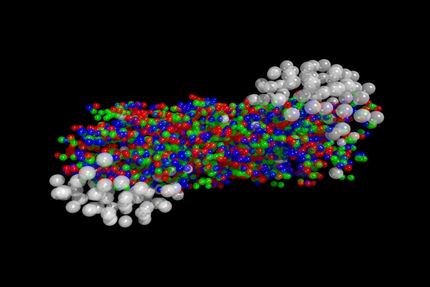A quark like no other
A University of Iowa physicist is at the forefront of the search for a missing particle that could prove whether the Higgs boson--believed to give mass to all matter--exists.

University of Iowa physicist Usha Mallik is at the forefront in the search to confirm the existence of a particle believed to give mass to all matter. Her group helped build and operates a sub-detector at the Large Hadron Collider, a particle accelerator in Switzerland, to search for bottom quarks, which are thought to appear when a Higgs boson decays.
Tim Schoon, University of Iowa
Usha Mallik and her team used a grant from the U.S. Department of Energy to help build a sub-detector at the Large Hadron Collider, the world's largest and most powerful particle accelerator, located in Switzerland. They're running experiments on the sub-detector to search for a pair of bottom quarks--subatomic yin-and-yang particles that should be produced about 60 percent of the time a Higgs boson decays.
Evidence of these bottom quarks would confirm the existence of the Higgs boson, sometimes referred to as the "God particle." The Higgs' apparent discovery in 2012 seemed to support the Standard Model, the prevailing theory in physics about how the laws governing the universe work.
But since that find, there's been a hitch: The bottom quarks expected to arise from a Higgs boson's decay have yet to be seen, and scientists need that to happen to know for sure the Higgs, in fact, exists.
"Until we're sure whether it's a Standard Model Higgs or an imposter mixed with another kind of Higgs, we are desperate to learn what is beyond the Standard Model. The Higgs is our window beyond the Standard Model," Mallik says.
Still, the quest remains complicated: A Higgs boson is created about once in 10 trillion tries. Moreover, Higgs bosons decay into other particles almost instantly after they are produced, which makes detecting and defining their decaying constituents--such as the bottom quarks--even more challenging.
Mallik and her team hope to observe bottom quarks by following the post-collision clutter that arises from the decay of the Higgs or other new heavy particles similar to it.
"It's basically identifying, picking that needle in the haystack while not getting fooled by something else," says Mallik, who spent the past academic year at ATLAS, one of four particle detectors at the Large Hadron Collider. "That is the challenge."
Mallik, three postdoctoral researchers, a graduate student, and a software engineer from the UI have all been at ATLAS sifting through the voluminous data produced by the collisions. Their work is funded through the High Energy Physics program, part of the U.S. Department of Energy's Office of Science.
Anindya Ghosh, a first-year UI graduate student from India joined Mallik's group in 2015 after hearing her speak the year before at the Indian Institute of Technology in Madras, India. Ghosh worked with the ATLAS experiments over most of last summer.
He calls it "a fantastic place" to be, with hundreds of scientists, students, and teachers joined in the same quest.
"It's a really great opportunity for a new student like me to learn from the experts," Ghosh says.
The attempt to understand the underpinnings of the universe--and human existence--has always fascinated Mallik.
"It's always interested me," she says. "How did we come into being? What led to our universe? It's a fundamental question in many forms."
Topics
Organizations
Other news from the department science

Get the chemical industry in your inbox
By submitting this form you agree that LUMITOS AG will send you the newsletter(s) selected above by email. Your data will not be passed on to third parties. Your data will be stored and processed in accordance with our data protection regulations. LUMITOS may contact you by email for the purpose of advertising or market and opinion surveys. You can revoke your consent at any time without giving reasons to LUMITOS AG, Ernst-Augustin-Str. 2, 12489 Berlin, Germany or by e-mail at revoke@lumitos.com with effect for the future. In addition, each email contains a link to unsubscribe from the corresponding newsletter.





























































